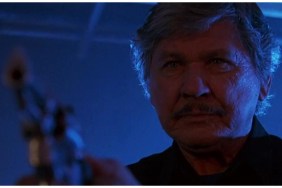A look at the importance of 1974’s landmark thriller Death Wish
Actor Charles Bronson to director Michael Winner on the last day of shooting 1973’s The Stone Killer:
Bronson: So, Michael, what are we going to do next?
Winner: Well, I have this script called Death Wish. It’s about a man whose family is assaulted by muggers and, to get revenge, goes around shooting muggers.
Bronson: I’d like to do that.
Winner: The film?
Bronson: Shoot muggers.
So began the conversational blueprint for one of the most influential thrillers of all time, 1974’s vigilante drama and Bronson star vehicle Death Wish, a movie that broke Hollywood’s rules, giving the world a character who reacts to the violence around him by becoming, in essence, a serial killer. And he’s the hero. And America — and the world — accepted him as such.
But Death Wish was almost never made. Winner, the prolific British director, was on a hot streak in the early ’70s with movies like the Marlon Brando horror film The Nightcomers and the Bronson actioneers Chato’s Land, The Mechanic and the aforementioned The Stone Killer. The two became close friends. In fact, Bronson’s wife, actress Jill Ireland, was once Winner’s lover, something that she amusingly failed to tell Bronson before he “introduced” her to his director and friend over dinner in the late 1960s. But that’s another story…
The book Death Wish by Brian Garfield was not a best seller but Winner liked it enough to commission a screenplay, one that no Hollywood producer wanted to touch. The story dealt with a mild-mannered liberal American whose life and ideals are dismantled when his wife is killed and daughter left virtually catatonic after street thugs assault them. The man buys a gun and, displeased with the police’s lack of motivation to catch the scumbags, enacts his own brand of rough justice.
The lack of sales for the source novel, coupled with the unique and unsavory concept of having a protagonist be a killer, scared the suits away. But Italian producer Dino De Laurentiis, on the cusp of moving his operation to Hollywood, loved the idea, loved Winner and really loved Bronson, who was a legend in Italy based on his work in Italian westerns and crime thrillers. De Laurentiis bankrolled the movie, the lead character was changed to suit Bronson’s tough, republican persona and the movie went even further into the reactionary vigilante nature of the novel. Whereas Garfield’s Paul Benjamin is never lauded for his eye-for-an-eye antics, Bronson’s Paul Kersey is positioned as righteous. And when Death Wish was released, he was an instant American movie hero.

America in the early 1970s was, of course, a very volatile country, or at least, with the advent of a more explicit, post-Vietnam news media telling-it-like-it-was, it was the birth or a less naive, more socially aware America. Stories of urban crime were battering down morale, with average working class citizens looking for answers. Because most of the reported street crimes were perpetrated by young, African-American men, Winner was urged to make the muggers in his Death Wish white, or at least anything but black. The thinking was that black audiences would reject and criticize the film for stereotyping and even further create hysteria and perpetuate the notion that one racial demographic was responsible for the current apparent surge in unsavory behavior. Winner – who although conservative in many of his views, was extremely liberal socially and anything but racist – thought it would be pandering to African-Americans by NOT making the muggers black, thinking that decent black viewers would WANT to see the scum “giving their people a bad name” punished. Either way, the point was moot when it came to casting as Winner simply hired the best men for the job, with the central leader of the gang that attacks Paul Kersey’s family led by a young, white man, played by Jeff Goldblum in what was his first feature film role. And he’s unforgettable in the part.
RELATED: Michael Winner remembers his 1977 horror film The Sentinel
At the time, Winner was dating actress Sonia Manzano, most famous for her role as Maria in iconic children’s TV series Sesame Street. Manzano is actually in the film at the beginning, when Goldblum and his fiends start to stalk Kersey’s wife and daughter at the supermarket. Manzano was head over heels for avant-garde jazz musician Herbie Hancock and convinced Winner to hire him to score the picture. Winner listened to Hancock’s 1973 album Head Hunters and fell in love with it and knew he had made the right choice. Hancock’s blistering, urgent score for Death Wish is what pushes it deep into the realm of horror movie. From the opening, with the sunny scenes of the Kersey family on the beach that suddenly slam at sunset to the ominous title card, you feel nauseous, like something is wrong, like there is a kind of “rot” at the heart of any perceived hope in the film. Hancock jerks the viewer around tormentingly, with electronic and organic instruments and hard sounds bashing against smoother jazz orchestrations. It’s one of the greatest film scores of the 1970s and one that rarely gets the credit it deserves.
Bronson is another actor and graduate of the western who, like John Wayne and Clint Eastwood, has had his work often dismissed by critics due to his naturally muted exterior. But like Wayne and Eastwood, Bronson was a great actor. With his permanent squint and brooding features, it’s often hard to “read” his emotions but Winner wisely dives close into Bronson’s eyes and it’s here that we see the essence of the character, the agony he endures when he stumbles around in a fog after the tragedy and the rapture and release he feels when he becomes an urban angel of death. It’s a fine performance and one that Bronson would trot out again in the many Death Wish sequels – the best of which were directed by Winner – though he was increasingly let down by the comic book nature of what the series became.

Back to the read of Death Wish as a horror movie: this writer has always seen the film as a contemporary Gothic and Kersey as a kind of vampire, albeit one armed with a moral code. He’s “bitten” when his family is decimated. And he goes through a period of transformation and adjustment. And then emerges a killer. And, like the vampire needs blood to feel whole, Kersey only feels alive when he takes out the murderous nightcrawlers he stalks. When his battered-down son-in-law comes to apartment to talk about the tragedy of what has happened to his wife, Kersey’s daughter, Paul is blasting Hancock’s jazzy groove, prepping liver for dinner and in a state of elation. When the younger man asks how he can be so upbeat, Kersey snaps back that he can’t mope around forever and then, grinning, goes back to his cooking. Kersey has become an addict and murder has become his junk. Death is his mission, his sole purpose for living. And it’s a far more fulfilling vocation than the life of an architect he hides behind during the day.
That’s really where the controversy that erupted after the success of Death Wish stemmed from, not only that Winner positions Paul Kersey as a hero, but that he actually LIKES to kill. He enjoys it. Such depictions, it was argued, might just inspire other citizens to take up arms after-hours against assailants, both real and imagined. It was a foolish argument then and remains one today. Death Wish is not a socially responsible movie. Nor should such pulp entertainments be looked to as such. It is indeed a horror movie. A fantasy. A character study of an imaginary person lost in an imaginary world that uncannily resembles our own. That said, the hyperbole surrounding the film certainly helped sell more tickets…
Death Wish changed everything and almost single-handedly gave birth to the entire vigilante crime thriller subgenre. Before Death Wish, only westerns celebrated a hero meting out such violent justice. But with Death Wish, the concept was dragged into a landscape the average person could identify with. Paul Schrader and Martin Scorsese’s urban horror masterpiece Taxi Driver owes much to Death Wish (even the final shots are metaphorically similar, suggesting that there is no end, that their antiheroes will kill again and again). As does the entire rape/revenge subgenre (what is I Spit on Your Grave but a film that melds both Kersey and his wife and daughter into single character). In fact much of the post-1974 exploitation market subsisted on vigilante vengeance films (Death Weekend, Rolling Thunder et al). Recently, films like Kill Bill and TV’s hit series Dexter celebrated the idea of a moralistic serial killer who kills less honorable killers. Both entertainments owe their bloody swords and scalpels to Winner and Bronson.

Death Wish is an electric film. It’s angry, immediate and dangerous. Eli Roth’s much hyped remake is likely due out later this year, with Bruce Willis cast in a version of the Bronson role. But no matter how that movie fares, the idea has been done and the deep, dark thrill of rough invention will most assuredly be absent. James Wan already kind of remade Death Wish as his own hardcore revenge opus Death Sentence (still Wan’s best film in my opinion) that starred Kevin Bacon in a stunning turn as one man retribution army. Amusingly, after the success of Death Wish, Garfield rushed a sequel to his original book to print called Death Sentence. And of course, while the first book faltered, THIS one was indeed a bestseller.
Death Wish is an American classic that has lost none of its sting. And at the heart of it, lies the unique friendship and creative marriage of Winner and Bronson, two larger than life personalities that have both sadly passed and whom pop culture will never see the likes of again.









